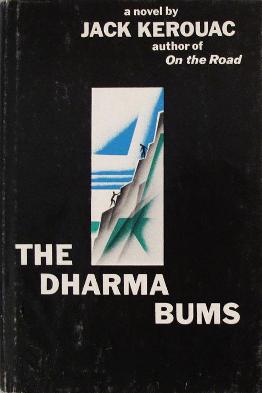 Jack Kerouac is synonymous with The Beat Generation which included Allen Ginsberg, William S. Burroughs, Neal Cassady, Gary Synder, Herbet Edwin Huncke, and others. This generation of storytellers and poets explored the post-World War II culture, questioning America’s mainstream values, spirituality, religion, sexuality, and drug culture.
Jack Kerouac is synonymous with The Beat Generation which included Allen Ginsberg, William S. Burroughs, Neal Cassady, Gary Synder, Herbet Edwin Huncke, and others. This generation of storytellers and poets explored the post-World War II culture, questioning America’s mainstream values, spirituality, religion, sexuality, and drug culture.
In a “Playboy” article Jack Kerouac explained the meaning of Beat:
“When I first saw the hipsters creeping around Times Square in 1944 I didn’t like them either. One of them, Huncke, came up to me and said, ‘Man, I’m beat.’ I knew right away what he meant somehow. Anyway those hipsters, whose music was bop, they looked like criminals but they kept talking about the same things I liked, long outlines of personal experience and vision, night-long confessions full of hope that had become illicit and repressed by War, stirrings, rumblings of a new soul (that same old human soul). And so Huncke appeared to us and said ‘I’m beat’ with radiant light shining out of his despairing eyes . . .”
 In 1958 for “Pageant” magazine Kerouac would define Beat further as one who is in “a state of beatitude . . . trying to love all of life, trying to be utterly sincere with everyone, practising endurance, kindness, cultivating a joy of heart” despite our mainstream world of consuming and meaningless distraction.
In 1958 for “Pageant” magazine Kerouac would define Beat further as one who is in “a state of beatitude . . . trying to love all of life, trying to be utterly sincere with everyone, practising endurance, kindness, cultivating a joy of heart” despite our mainstream world of consuming and meaningless distraction.
Kerouac was a writer, but more than anything he was a storyteller. His works were not exactly fiction but tales of life on the road. He recorded the Beat generation and gave their stories to the hippie generation, showing them an alternative to suburban life. In “The Dharma Bums,” Kerouac described something different for Americans “all of them imprisoned in a system of work, produce, consume, work, produce, consume, I saw a vision of a great rucksack revolution thousands or even millions of young Americans wandering around with rucksacks, going up to mountains to pray, making children laugh and old men glad, making young girls happy and old girls happier . . .”
 Jack Kerouac became an icon frozen in the early 1950s helped by his withdrawal from the public eye and his early death at the age of 47 in 1969. After his death, Allen Ginsberg promoted his work to a new generation. Generations since have redefined his work for their place and time. Kerouac is still relevant today not because he or his writing was flawless but for the simple reasons that he was a keen observer of human interaction—he was nicknamed “Memory babe” as a child, his work encourages an alertness to and questioning of the world around him, his writing showed people being brutally honest with each other—people who were comfortable “letting it all hang out,” and he was a writer who was real—“a writer who has been there” as Allen Ginsberg described in Kerouac’s obituary.
Jack Kerouac became an icon frozen in the early 1950s helped by his withdrawal from the public eye and his early death at the age of 47 in 1969. After his death, Allen Ginsberg promoted his work to a new generation. Generations since have redefined his work for their place and time. Kerouac is still relevant today not because he or his writing was flawless but for the simple reasons that he was a keen observer of human interaction—he was nicknamed “Memory babe” as a child, his work encourages an alertness to and questioning of the world around him, his writing showed people being brutally honest with each other—people who were comfortable “letting it all hang out,” and he was a writer who was real—“a writer who has been there” as Allen Ginsberg described in Kerouac’s obituary.
Kerouac’s loose, spontaneous writing style inspired writers like Vladimir Nabokov, Henry Miller, Tom Wolfe and Michael Herr’s record of the Vietnam war “Dispatches.” Even though his fast style revealed good and bad writing, Kerouac is a reminder that serious writing can be about anything in any style of writing.
 Since a resurgence of interest in his work in the seventies, all of Jack Kerouac’s books have remained in print. First editions of his books are scarce and valuable among collectors. “The Dharma Bums,” largely considered to be his most accessible work, will sell for upwards of a $1000. His literary and personal archive were secured at the New York Public Library in 2001, and in 2007 Penguin published the original 120-foot scroll of “On the Road,” energizing Kerouac’s work for the next generation.
Since a resurgence of interest in his work in the seventies, all of Jack Kerouac’s books have remained in print. First editions of his books are scarce and valuable among collectors. “The Dharma Bums,” largely considered to be his most accessible work, will sell for upwards of a $1000. His literary and personal archive were secured at the New York Public Library in 2001, and in 2007 Penguin published the original 120-foot scroll of “On the Road,” energizing Kerouac’s work for the next generation.
Written by Lisa Newman. Original to the Clarion-Ledger Sunday print edition (August 20)


Comments are closed.